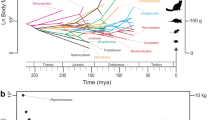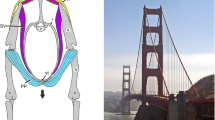Abstract
The dimensions of the distal leg muscles in ten different primate species were examined, in order to determine whether locomotor specialisation is reflected in the fibre and tendon lenghts of the muscles. A non-primate was included in the study for comparison. The locomotor specialisations which the investigated species displayed were leaping, quadrupedal walking or running on the ground and brachiation.
Access this chapter
Tax calculation will be finalised at checkout
Purchases are for personal use only
Preview
Unable to display preview. Download preview PDF.
Similar content being viewed by others
References
Alexander R. McN. & Bennet-Clark H.C., 1977. Storage of elastic strain energy in muscle and other tissues. Nature, 265: 114–117.
Alexander R. McN., Jayes A.S., Maloiy G.M.O. & Wathuta E.M., 1981. The allometry of the leg muscles of mammals. Journal of Zoology, 194: 539–552.
Andrews P. & Groves C.P., 1976. Gibbons and brachiation. In: Gibbon and Siamang (D.M. Rumbaugh ed.) Karger AG Basel, 4: 167–218.
Demes B. & Günther M.M., 1989. Wie die Körpermasse den Springstil von Halbaffen und deren Proportionen bestimmt. Z. Morph. Anthrop., 77: 209–225.
Dimery N.J., Alexander R. McN. & Ker R.F., 1986. Elastic extension of the leg tendons in the locomotion of horses (Equus caballus). Journal of Zoology, 210: 415–425.
Gebo D.L. & Dagosto M., 1988. Foot anatomy, climbing, and the origin of the Indriidae. Journal of Human Evolution, 17: 135–154.
Hall-Craggs E.C.B., 1977. Physiological and histochemical parameters in comparative locomotor studies. In: Prosimian Anatomy, Biochemistry and Evolution (R.D. Martin, G.A. Doyle & A.C. Walker eds.) Duckworth & Co Ltd London, 11: 829–845.
Huxley A.F. & Peachey L.D., 1961. The maximum length for contraction in vertebrate striated muscle. Journal of Physiology, 156: 150–165.
Jolly C.T. & Gorton A.T., 1977. Proportions of the extrinsic foot muscles in some Lorisid prosimians. In: Prosimian Anatomy, Biochemistry and Evolution (R.D. Martin, G.A. Doyle & A.C. Walker eds.) Duckworth & Co Ltd London, 11: 801–815.
Jungers W.L., 1985. Body size and scaling of limb proportions in primates. In: Size and Scaling in Primate Biology (W.L. Jungers ed.) Plenum Press New York/London, 345–382.
Ker R.F., Alexander R. McN. & Bennett M.B., 1988. Why are mammalian tendons so thick? J. Zool. Lond. 216: 309–324.
McArdle J.E., 1981. Functional morphology of the hip and thigh of Lorisiformes. Contrib. Primatol., 17: 1–132.
Oxnard C.E., 1963. Locomotor adaptations in the primate forelimb. Symposium of the Zoological Society of London, London, 10: 165–182.
Peters A. & Preuschoft H., 1984. External biomechanics of leaping in Tarsius and its morphological and kinematic consequences. In: Biology of Tarsiers (C. Niemitz ed.) Gustav Fischer Verlag, Stuttgart.
Preuschoft H., 1963. Muskelgewichte bei Gorilla, Orang-Utan und Mensch. Anthropologischer Anzeiger 26, 4: 308–317.
Preuschoft H., 1965. Muskeln und Gelenke der Vorderextremität des Gorillas (Gorilla gorilla, Savage et Wyman 1847). Morphologisches Jahrbuch, 107 (2): 99–183.
Preuschoft H. & Demes B., 1985. Biomechanic determinants of arm length and body mass in brachiators. In: Fortschritte der Zoologie (Duncker & Fleischer ed.) Gustav Fisher Verlag, Stuttgart, 30: 39–43.
Schultz A.H., 1956. Postembryonic age changes. In: Primatologia, Handbuch der Primatenkunde: (H. Hofer, A.H. Schultz & D. Starck ed.) S. Karger Basel/New York, 887–964.
Schultz A.H., 1963. The relative lengths of the foot skeleton and its main parts in primates. Symposium of the Zoological Society of London, 10: 199–206 London 1963.
Stern J.T. & Oxnard C.E., 1973. Primate locomotion: some links with evolution and morphology. In: Primatologia, 4(11) (H. Hofer, A.H. Schultz & D. Starck ed.) S.Karger Verlag Basel.
Wilke D.R., 1976. Muscle. Studies in Biology 11. Edward Arnold Ltd London.
Editor information
Editors and Affiliations
Rights and permissions
Copyright information
© 1993 Springer-Verlag/Wien
About this chapter
Cite this chapter
Rauwerdink, G.P. (1993). Muscle fibre and tendon lengths in primate extremities. In: Preuschoft, H., Chivers, D.J. (eds) Hands of Primates. Springer, Vienna. https://doi.org/10.1007/978-3-7091-6914-8_14
Download citation
DOI: https://doi.org/10.1007/978-3-7091-6914-8_14
Publisher Name: Springer, Vienna
Print ISBN: 978-3-7091-7434-0
Online ISBN: 978-3-7091-6914-8
eBook Packages: Springer Book Archive




